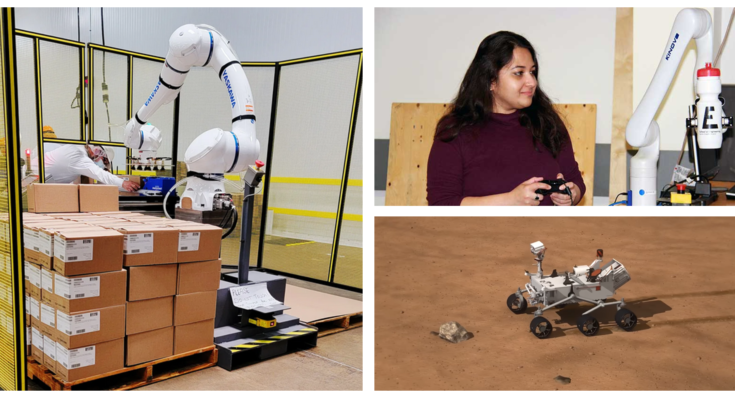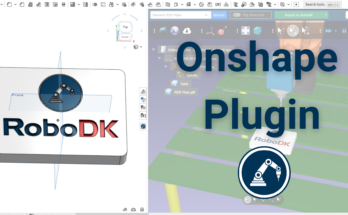The most intriguing robotics news brought to you by the team at RoboDK.
Industrial Robot Brief
CES 2022 ensured that January kicked off in spectacular fashion, with new humanoids, Samsung’s plans to enter the US robot market, and Deere’s autonomous tractor grabbing most of the headlines.
There were some interesting industrial technologies debuted at the show too, including the new Intel Alder Lake S-series and H-series processors for edge computing and IoT applications, Ubiquity Robotics‘ low cost, ROS-based, mobile robot dubbed ‘Conveyor,’ and Doosan’s upgraded Smart Farm solution.
Elsewhere, speaking about Tesla’s plans to develop a humanoid robot, CEO Elon Musk mused that the project “has the potential to be more significant than the vehicle business over time” and grocery delivery giant Ocado revealed that it’s using 3D printing technology to build the pick-and-pack robots used in its fulfillment centers in an effort to improve packaging efficiency and reduce operating costs.
Also in January, autonomous mobile robot maker MiR announced a 42% increase in sales over 2021 and cobot pioneer Universal Robots reported record annual revenue of USD 311 million, a 41% increase on 2020 and 23% up on pre-pandemic results in 2019.

DHL Supply Chain announced a USD15 million investment in automation from Boston Dynamics (starting with deployments of the latter’s eye-catching ‘Stretch’ robot on unloading processes in distribution centers), and Fanuc unveiled the M-1000iA, its most powerful serial-link industrial robot to date, with a payload of 1000 kg.
The Rise of RaaS
Robotics-as-a-service (RaaS) business models allow companies to enjoy the benefits of automation by leasing robots and components rather than buying them outright. The emergence of RaaS in recent years has been one of the most exciting trends in industrial robotics –especially for smaller companies that have traditionally been unable to deploy automation due to the capital costs involved.

Today, by leveraging RaaS opportunities, companies can rent automation at an hourly rate that’s considerably less than hiring a human worker. Market analysts ABI Research estimate that the installed base for RaaS will grow from 4,442 units in 2016 to 1.3 million by 2026.
Wired covered this topic and the implications for factories and labor, in January, reporting that:
Lynn Wu, an associate professor at the University of Pennsylvania’s Wharton School and a coauthor on the 2019 study, says she expects robots paid by the hour to become more common. But she notes that in contrast to many information technologies, few businesses know how to use robots. “It’s going to take longer than people think,” she says.
New Human-Robot Collaboration Research
With humans and robots intercting more than ever before, researchers are racing to understand and improve human-robot collaboration, particularly in industrial environments.
Chinese researchers have developed a closed-loop human-machine interface that integrates auditory, visual and haptic virtual reality (VR) into a robotic VR system. The system uses skin-tone elastomeric silicon as an adhesive interface to the user’s skin. Copper wires connect the battery, sensors and other electronics and wireless transmission enables the wearer to send instructions to a remote machine. (H/T AZO Robotics)

Meanwhile, researchers at China Three Gorges University claim to have developed a system that uses a combination electrical readings from muscles and brainwaves to read a human co-worker’s mind with 96 per cent accuracy.
The co-worker did not need to say or do anything when they needed a tool or a component, as the robot would recognise the intention almost instantly, picking up the object and putting it on the workstation, according to the developers.
—South China Morning Post, Jan 06, 2022
Elsewhere, a study published January in PLOS ONE found that humans mirror the movement of humanoid robots that they’re interacting with. Additionally, the rhythmic coordination between human and robot looks similar to that between humans. Popular Science reports: “Most participants noticed that they were synchronizing with the robot, but they were unsure of whether it was themselves or the robot who was the one adjusting their tempo. Perhaps finding a way to measure intentionality through EEG or fMRI could be a next step in mapping this behavior pattern onto neurobiology, [lead researcher] Ghiles Mostafaoui proposes.

And Safety & Health Magazine reported on the work of researchers at the University of British Columbia, Canada, into human-robot collaboration. The team has developed a system that combines artificial intelligence and machine learning to help robots predict what other robots and humans will do, and respond appropriately. Upcoming is a paper from Debasmita Mukherjee, a doctoral student, that’s expected to include a novel taxonomy of levels of interaction between humans and robots and a comprehensive review of the machine learning methodologies and industrial applications of the same in the context of adaptable collaborative robots.
Blue Origin To Acquire Honeybee Robotics
Jeff Bezos’ Blue Origin has announced plans to acquire Honeybee Robotics, a company that specializes in the development of space-based robotic systems. The terms of the deal were not disclosed.
Founded in 1983, Honeybee Robotics has developed automation for several Mars missions (see video below) and is currently collaborating with NASA on the Dragonfly mission to explore Saturn’s moon Titan.
Blue Origin hasn’t disclosed its long-term plans for Honeybee, but, as Space News reported, both Blue Origin and Bezos “have long discussed using space resources to enable the expansion of humanity into space,” so it seems likely that the acquisition will see further expansion and development of Honeybee’s mineral extraction and testing robots and tools.
Goldfish drives its tank to find food
The viral star of January’s robotics news was not a robot, but a goldfish. Like something from Douglas Adams’ Hitchhiker’s Guide To The Galaxy, the goldfish can move its ‘Fish Operated Vehicle’ –which is also an aquarium and a robotic platform– around in order to reach a reward. Developed by researchers at Ben-Gurion University of the Negev in Israel, the system was designed to test the navigational capabilities of goldfish.
Over time, the researchers found that the fish came to understand that their actions could impact the movement of the FOV in desired ways, leading them to a tasty reward. Next, the team changed the environment—the fish drove their little FOV around both indoor and outdoor arenas and with changing targets and obstacles. They found the fish had no problems adapting; they drove straight for their reward, demonstrating their ability to use the FOV to navigate to desired locations.
‘Goldfish taught to drive little land vehicle to desired targets,’ PhysOrg, Jan 05, 2022
RoboDK’s Reading
Five more robotics news items from January that grabbed our attention.
- Kirigami robotic grippers are delicate enough to lift egg yolks (Science Daily)
- Helping hands: how cobots are closing the productivity gap (The Engineer)
- China’s 5-year plan aims for global leadership in robotics (Industry Europe)
- LG launches CLOi service robot after gaining UL certification (Robotics & Automation News)
- Why we are living in an era of unnatural selection (BBC)
What is your favorite robotics news? Tell us in the comments below or join the discussion on LinkedIn, Twitter, Facebook, Instagram, or in the RoboDK Forum.. Also, check out our extensive video collection and subscribe to the RoboDK YouTube Channel.




